Understanding LSD
What is LSD?
LSD, or lysergic acid diethylamide, is a synthetic chemical derived from the ergot fungus that infects rye grain. It is classified as a potent hallucinogen, belonging to a group of drugs known as psychedelics. LSD alters an individual's perception of reality, leading to changes in mood, thought, and sensory perception. Small doses can cause mild effects, while larger doses may result in vivid visual hallucinations and significant distortions of space and time.
LSD is typically found in various forms, including powder, liquid, or tablet, and is often referred to by street names like acid, blotter, purple haze, and window pane. Although many users seek out the drug for its psychedelic effects, it is critical to note that LSD can be sold under different names, such as NBOMe or the 2C family of drugs, which can pose serious health risks due to inconsistent quality and potential for overdose.

Legal Status of LSD
The legal status of LSD varies by country and region, as it is classified as an illegal drug in many parts of the world. In the United States, LSD is classified as a Schedule I controlled substance, meaning it is considered to have a high potential for abuse and no accepted medical use. The same classification applies in other countries, contributing to the stigma and regulatory challenges surrounding this substance.
Many jurisdictions have seen discussions surrounding the potential therapeutic benefits of psychedelics, including LSD, leading to changes in legislation. Researchers have explored LSD’s possible use in treating mental health issues like chronic alcoholism and mental illness during the 1950s and 1960s, as noted by CAMH. While some areas are beginning to re-evaluate these substances for therapeutic use, LSD remains illegal in most places, highlighting ongoing debates about its risks and benefits.
For more information on the various risks associated with LSD, including short- and long-term effects, visit our section on risks and concerns with LSD use.
Effects of LSD
The effects of LSD can vary significantly from person to person and depend on factors such as dosage, individual psyche, and environment. LSD influences the brain's chemical processes, particularly those involving serotonin, leading to changes in mood, perception, and behavior.

Short-Term Effects
Shortly after ingestion, typically around 30 minutes, users begin to experience the effects of LSD, which can last between 8 to 12 hours. During this period, individuals may encounter a variety of emotional and physiological impacts, including:
EffectDescriptionEuphoriaFeelings of extreme happiness and excitementHallucinationsVisual and auditory distortions of realityChillsSensations of cold or shiversConfusionDifficulty in thinking clearlyFast Heart RateIncreased heart rate and blood pressure
These effects are often referred to as "trips," which can lead to positive or negative experiences based on the person's mindset and environment. A significant point to remember is that not all trips are pleasant; negative experiences, often called "bad trips," can result in feelings of anxiety or paranoia.
Long-Term Effects
Regular use of LSD can lead to several long-term effects, which may include both psychological and physical consequences. Some of these effects are:
EffectDescriptionFlashbacksRecurrent visual distortions can emerge unexpectedly weeks, months, or even years after the last use, triggered by various stressors [1].Mental Health IssuesPotential exacerbation of conditions like anxiety, schizophrenia, or psychosis. Note that controlled doses in therapeutic settings have shown promise in treating conditions like PTSD and depression [1].ToleranceIncreased consumption over time may lead to the need for higher doses to achieve similar effects [2].
LSD's mind-altering effects highlight its impact not only on the immediate experiences of users but also on their long-term mental health. Understanding these effects is critical for making informed decisions regarding LSD use. For a deeper dive into seeking help, individuals can explore options like experiential therapy: 7+ innovative treatments to help you heal or life after addiction: what to expect.
Risks and Concerns with LSD Use
LSD, commonly known as acid, is a powerful hallucinogenic drug. Understanding the risks associated with its use is vital for anyone considering or currently using this substance. This section addresses two significant concerns: addiction potential and polysubstance use.

Addiction Potential
While LSD is not typically associated with physical dependence, it can still be addictive for some individuals. Users may feel compelled to use the drug repeatedly, leading to emotional and lifestyle issues. Although regular users do not usually experience physical withdrawal symptoms, they can develop a tolerance to LSD. This tolerance means that they may require higher doses to achieve the desired effects over time.
AspectDescriptionPhysical DependenceRarely occursPsychological DependenceCan developToleranceCan require larger doses over time
Polysubstance Use
Polysubstance use refers to the concurrent use of LSD with other substances like alcohol, marijuana, cocaine, and tobacco. Engaging in polysubstance use can lead to several harmful consequences, including acute toxicity and serious health risks. This combination can result in heightened effects, emergency room visits, hospital admissions, overdose, or even death.
Substance UsedRisksAlcoholIncreased likelihood of overdose or dangerous behaviorMarijuanaAlters the effects of LSD, potentially leading to anxietyCocaineHeightened heart rate and risk of heart issuesTobaccoMay increase dependency and health problems
Awareness of these potential risks is crucial when considering the use of LSD. Those who use LSD alongside other substances must be especially cautious, as this can significantly amplify the dangers associated with drug use. For more information on addiction treatment options, visit our article on life after addiction: what to expect.
Forms and Administration of LSD
LSD, or lysergic acid diethylamide, is a potent hallucinogen that comes in various forms, each with unique methods of administration. Understanding these forms and techniques is essential for those seeking to comprehend the intricacies of this substance.
Different Forms of LSD
LSD is available in several formats, allowing users various ways to consume it. The most common forms include:
FormDescriptionTabletsSmall, pressed pills containing LSD.CapsulesGelatin capsules filled with LSD powder or liquid.LiquidLSD in liquid form, often dispensed using an eye dropper.Blotter PaperSpecially treated paper with LSD, cut into small squares that users can place on their tongues for absorption. Users tear a square along the perforated lines and allow it to dissolve on their tongues [4].
These various forms particularly allow for flexibility in use but come with distinct risks and effects.
Administration Techniques
The methods for administering LSD differ based on its form. Each technique impacts how the drug interacts with the body and the intensity of its effects. Here are some common administration techniques:
Understanding these forms and administration techniques can help individuals make informed choices regarding LSD. As with any substance, awareness of its potential risks is crucial for safety.
For more insights into addiction and therapy, consider exploring experiential therapy: 7+ innovative treatments to help you heal or life after addiction: what to expect.
Legal Status of LSD Worldwide
Legal Status in Various Countries
The legal status of LSD varies significantly across different countries. While some nations maintain strict regulations, others have started to explore decriminalization or legalization in specific contexts. Here’s a table illustrating the status of LSD in various regions:
Country/RegionLegal StatusUnited StatesSchedule I (illegal, with some states decriminalizing)CanadaSchedule III (legal with restrictions)United KingdomClass A (illegal)AustraliaSchedule 9 (illegal; recent changes allow some psychedelics for medical use)BrazilDecriminalized in certain contextsPortugalDecriminalized for personal useSouth AfricaDecriminalized for personal use, medical use allowed for certain substancesNetherlandsLegal in specific forms (truffles)JamaicaNo legal restrictions
LSD is classified as a Schedule I substance in the United States, meaning it is considered to have no accepted medical use and a high potential for abuse. However, some states have started to take steps towards decriminalization or have established more lenient laws regarding psychedelic substances [5].
Recent Changes in Legislation
In recent years, there has been a notable shift in the legislative landscape concerning psychedelics, including LSD. Certain jurisdictions are now recognizing potential therapeutic benefits and are moving towards more progressive policies.
As of July 1, 2023, Australia permitted the prescribing of MDMA and psilocybin for patients with PTSD and treatment-resistant depression under the Therapeutic Goods Administration. This legislative change reflects a growing acknowledgment of the potential mental health benefits associated with psychedelic compounds [6]. Similarly, countries in Central Africa, along with a number of nations in Europe and South America, are exploring decriminalization and use in medical settings [5].
These evolving laws highlight a broader trend towards re-evaluating the role of psychedelics in healthcare and society, potentially altering public perception and acceptance of substances like LSD in the near future.
Treatment and Recovery Options
Recognizing LSD Abuse
Recognizing LSD abuse is essential for addressing the issue effectively. Individuals who misuse this drug may show various signs that indicate a problem. Symptoms can include:
While LSD may not cause physical withdrawal symptoms, its psychological effects can create significant challenges in one's life. Assistance should be sought promptly if these signs are present.
LSD abuse often leads to emotional and lifestyle difficulties, making it hard for individuals to function normally. If there are concerns about drug misuse, immediate help is critical. Nationwide drug treatment centers offer care tailored to the needs of those struggling with substance abuse and mental health issues.
Seeking Help and Support
Seeking help for LSD abuse can involve several key steps. It is important to consult a healthcare provider if someone is using LSD and needs assistance in discontinuing its use. Medical professionals can provide guidance on treatment options and develop a tailored recovery plan.
Support resources include:
It is vital for individuals seeking recovery to engage in programs designed to address not just the substance use but also the underlying issues that led to the abuse. These approaches can significantly improve one's chances of long-term recovery. For further reading on treatment options, check our resource on experiential therapy: 7+ innovative treatments to help you heal.
Additionally, support from family and friends plays a crucial role in recovery. Open conversations about the challenges associated with LSD and other substances can foster a supportive environment. Seeking professional help and relying on personal support systems are integral in the journey toward recovery.
References
[2]:
[3]:
[4]:
[5]:
[6]:

.svg)

.svg)

.svg)
.svg)









































































































